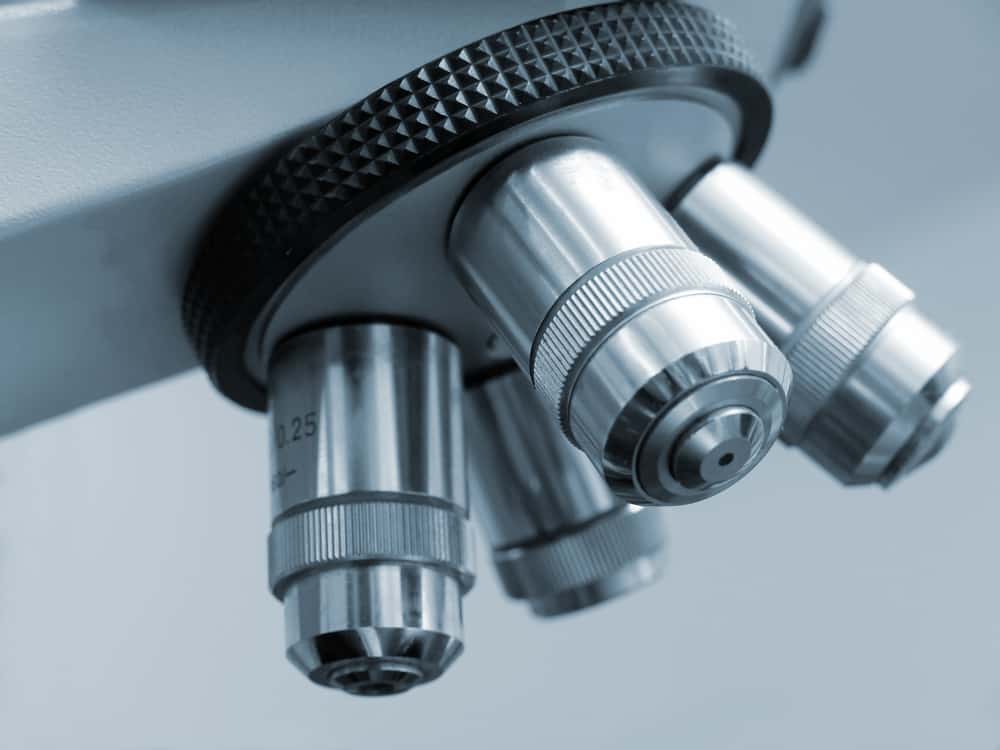
In the microscope world, people often consider the most important microscope part to be the lens. While this may be true, other components are key to the functioning of the microscope as well as the accuracy of the image. One of those components is the nosepiece.
The microscope nosepiece is an essential part of the microscope. Keep reading to find out its exact function and why it’s so important.
Contents
What Is a Microscope Nosepiece?
The microscope nosepiece is the part of a microscope that sits just below the head of the microscope and locks the objective lens into position by rotating in either direction to the subsequent objective lenses. It is attached by a nose piece screw, which can be loosened and tightened as needed. It is easy to identify due to its distinct disc shape.
Invented in 1928, it has been attributed to a lot of time savings for scientists when observing a specimen on the mechanical stage under the lens.
The microscope nosepiece can hold anywhere from three to five lenses, depending on the microscope, and come in various magnitudes. This piece aims to change between the objective lenses and help you find the right one for your viewing purposes.
Microscopic nose pieces are designed to lock the objective lens into place and keep it aligned and centered with the specimen under the lens. This eliminates the need to reposition the microscope slide and also puts the specimen into focus a lot quicker.
Why Hold Multiple Objective Lenses?
The objective lens of a telescope magnifies the image. Each objective lens has varying levels of magnification.
Often, it takes some trial and error to find the objective lens that works best for your purposes. Before the arrival of nosepieces, this meant removing and replacing lenses one after another.
However, with a revolving nosepiece, switching between different lenses is simple, and you can find the right objective lens and focus in a matter of seconds. Let’s take a closer look at how to use a microscope nosepiece.

How to Use a Microscope Nosepiece
Knowing how to use a microscope nosepiece is part of the basics of working with simple microscopes. Luckily, using this component is very easy.
You want to start with your microscope at the lowest power objective lens. Make sure that it is locked into place. From there, rotate the nosepiece to the higher magnification power objective as you look through the eyepiece. Then, use the coarse adjustment knob and fine focus knob to fine-tune the image.
For the nosepiece to revolve, you must grasp the objective with the grip section of the objective lens. From there, you rotate it to the lens you want, whether on the left or right. Some nosepieces have the grip directly on them, so you should be turning that directly.
How to Remove Objective Lens from Microscope Nosepiece
It’s possible to remove the objective lenses from a microscope nosepiece. There are many reasons why you might want to do that, but the most common is to clean the lens and microscope.
All you have to do is twist the revolving nosepiece and unscrew the objective lens. Putting it back involves doing the same thing, just in reverse. Despite the simplicity, you must be careful when removing an object from the nosepiece. You don’t want to end up scratching or damaging the objective in any way.
Benefits of the Nosepiece
A microscope nosepiece makes research a lot easier in many ways.
First and most important, a microscope nosepiece is versatile and flexible. They can accommodate a variety of different types of objectives and lenses.
You can also switch between several objective lenses and add or remove objective lenses from the rotation if necessary.

Microscope Nosepiece FAQs
Can I add or remove objective lenses from the nosepiece?
Most microscope nosepieces can hold anywhere from three to five objective lenses. You can easily switch between them based on the specimen you’re viewing and the required objective power needed.
That said, you must carefully remove objective lenses from the microscope nosepiece. It’s essential to ensure the objective lenses are compatible with your nosepiece, especially if they’re from different manufacturers. Most microscope nose pieces usually come with the objective lenses most scientists need for their microscopes.
How many objective positions are typically found on a microscope nosepiece?
You’ll usually find three or four objective lens positions on a microscope nosepiece. They almost always consist of the following powers, starting at the lowest power objective lens to higher magnification: scanning (4X), low (10X), high (40X), and oil immersion (100X).
Can I upgrade the nosepiece on my existing microscope?
While exchanging and upgrading the nosepiece of your existing microscope is possible, it isn’t always worth it and may not deliver the desired results.
There are more effective ways to produce a better image quality than upgrading your nosepiece. The improvement might not be as significant as one might hope for.
Recap: Microscope Nosepieces Save Time and Ensure Accuracy
To recap, the microscope nosepiece is a crucial microscope part and how you use it. It facilitates objective switching for magnification changes to ensure your image is as clear and magnified as possible.
So next time you’re looking for a new microscope, pay close attention to the revolving turret nosepiece as well. To help you, check out this article to learn more about electron microscopes, compound microscopes, and stereo microscopes.

